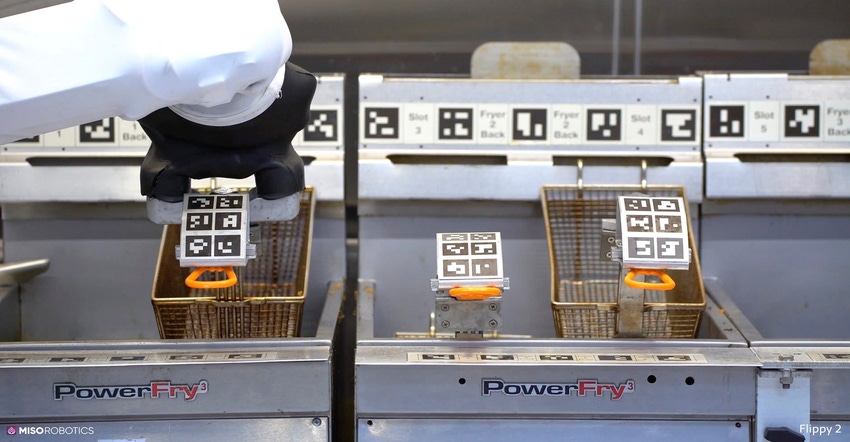Robots Are Taking over Fast Food Jobs
The restaurant kitchen of the future will be automated, with humans doing what they do best, customer service.
December 13, 2022

Miso specializes in robotics for food service, offering robot systems that pour drinks and cook fries. The company is working to offload more and more of the restaurant work to automated systems. Deploying robots is similar to employing people – you hire them. Miso uses the RaaS (robots-as-a-service) system. Restaurants hire robots with a monthly payment. The system makes the ROI relatively simple. Restaurants can compare the monthly cost of a robot with the monthly cost of an employee.
We caught up with Jake Brewer, chief strategy officer at Miso, to get his views on the future of robots in food service.
Design News: Where do you see the most potential for robots in food service in 2023?
Jake Brewer: In 2023, restaurants will focus on scaling and adoption. We are past the point where it’s a question about whether robotics and automation are going to be implemented. Now it’s a matter of where in the kitchen. The drink station and the fryers are where we are starting in a big way as they have operationally the largest potential impact on the restaurant.
DN: What other issues are robots solving in food service?
Jake Brewer: Over the past two and a half years, the restaurant industry was forced into a new set of dynamics to stay operational. Unfortunately, the lack of labor has made efficiency a challenge. Staff shortages have always made operational success difficult – and now we are seeing an all-time high number of open positions and amplified turnover rates.
No one is fighting to fill those back-of-house positions anymore. Operators need to help support the staff that did return. Robots streamline operations and provide a better customer experience. They establish overall improvement and stability in the business. For the workers who are there day in and day out, their jobs get easier. For operators, there’s suddenly a better, promotable work environment to attract talent.
Additionally, labor-intensive, repetitive, and, frankly, dangerous tasks like manning the fryer aren’t roles that are attracting workers. That’s where robotics comes in. We seek to offload those types of tasks in the back-of-house, freeing up humans to do what humans do best, such as customer service.
This video illustrates the future of robotics in food service:
DN: What do you see going forward in restaurant technology
Jake Brewer: More restaurants piloting and deploying automated solutions for back-of-house operations. We will also see changes in front-of-house and drive-thrus with more sophisticated kiosks that can make fresh food or take your order respectively with just the touch of a button.
DN: Explain how the ROI typically works with robot adoption at restaurants.
Jake Brewer: Our robot, Flippy costs $3,500 per month to work the fry station, a role that would typically be staffed for about 8-12 hours each day, costing around $4,500. In this regard, the payback is immediate.
However, the reality is that the role is largely unfilled. As a result, when you break down the operating cost of Flippy (maintenance included) for 12 hours, the cost is roughly $9.80 per hour.
DN: How are the major restaurant brands deploying robotics?
Jake Brewer: Here’s a brief description of the robot deployments at our food-service partners.
At White Castle, we expanded our initial partnership in 2020 from a piloted test of Flippy to deploying Flippy 2 at 100 more of its restaurants this year.
At Chipotle, the brand initially tested Chippy at the Chipotle Cultivate Center, Chipotle’s innovation center, and later piloted Chippy in one of its restaurants in Fountain Valley.
At Jack in the Box, the brand piloted our core product lines, Flippy 2 and Sippy, in one of their standalone locations with plans for further integration in the months ahead.
At Panera, the brand began testing CookRight Coffee to support Panera’s Unlimited Sip Club membership.
At Wings and Rings, the brand piloted Flippy 2 in its Crestview Hills, Kentucky location, with possible plans for further integration.
At Wing Zone, we partnered to standardize Flippy 2 into all of Wing Zone’s future restaurant builds, making the brand the first to spec food robotics into its operations at this level.
DN: What trends do you see going forward in restaurant technology?
Jake Brewer: Looking ahead, big brands will feel more comfortable dipping their toe into true future tech and fully automating certain aspects of the restaurant kitchen and beyond.
As the industry works towards the “kitchen of the future,” we aim to apply AI, automation, and robotics to bring innovation to a restaurant’s back-of-house and address the challenges plaguing the industry. In addition to our current offerings, we are also working with brands to design future build kitchens specifically for automation.
About the Author(s)
You May Also Like





